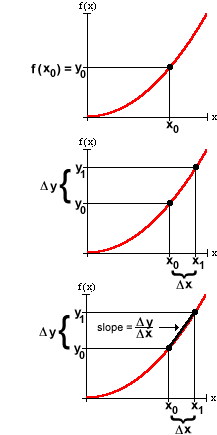
Value, Change, Rate of Change
Many important questions about functions are local questions. We often wish to know what a function's behavior is like at or near specific choices for the independent variable. For example, we may ask:

This question asks: "For this particular value of x, what will be the value of the associated output
If
Rate, as in everyday usage, refers to "how fast." To say how fast something – like the value of a function – is changing, we need to know not only how much it has changed, but also the length of the interval over which it has changed. If
![]()
Notice that the rate goes up if either Dy increases or if Dx decreases. That is, a certain change in value over a short interval will correspond to a greater rate of change than, say, the same change in value over a longer interval. Similarly, the rate will go down if either Dy decreases or if Dx increases.
The units for measuring rates are "change in output per change in input." Some familiar examples include miles per hour and cycles per second.
|
|
|
...to Examples |
| Back to Contents | ||